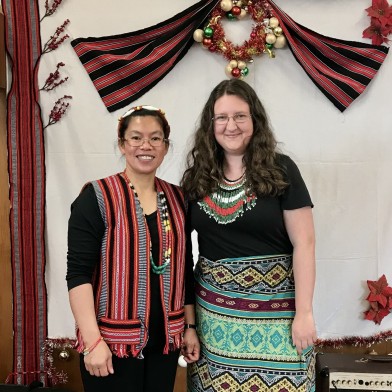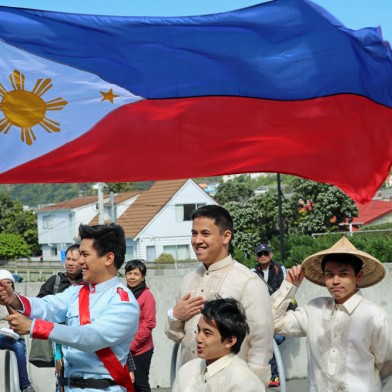In a vibrant celebration of heritage and unity, the Igorot people from around the globe converged in New Zealand, marking a significant moment of cultural affirmation within the continuously changing global fabric. This assembly, which served as a demonstration of the resilient determination of the Igorot diaspora, was accentuated by a cultural evening, and the Asia Media Centre was present in the event.
As the evening lights illuminate the Te Atatū Peninsula Community Hall in Auckland, members of the Igorot community, hailing from diverse tribes, take center stage. Their performances are a visual feast, with traditional dances that seem to narrate tales of their ancestral lands.
Each member wore meticulously handwoven textiles, their patterns a rich display of the craftsmanship nurtured in the northern mountains of the Philippines. These vividly coloured garments, which were firmly rooted in custom, functioned not only as clothing but also as a link between the past and the present.
The Ifugao dance, performed by members of the Ifugao tribes in New Zealand. Photo: Carla Teng/AMC.
In an interview, Myriam Benito, President of the Organisation of Cordillerans in New Zealand (OCNZ), talked about the significance of this gathering for the Igorot community. She highlighted how this event is crucial for Igorot identity, especially as they strive to preserve their cultural legacy in today’s world.
She explained, “this is the Igorot global organisation’s key event, which held every two years, and it aims to connect Igorots worldwide, and this is the 14th Igorot international consultation. It initially started in California. So, the idea is to exchange and network with fellow Igorots worldwide. This is our first time ever hosting in New Zealand.”
Benito and the OCNZ team were excited to welcome Igorots to Aotearoa from different parts of the globe, including the Philippines, USA, Australia, UK, Austria, Canada, and others. They were delighted to introduce to their fellow Igorots the rich and unique Māori culture of New Zealand.
The OCNZ was founded in Auckland and has been active since 1995.
Who are the Igorot people of the Philippines?
Nestled in the northern part of the Philippines lies the Cordillera region, a tapestry of rugged mountains and rich traditions spanning six provinces: Abra, Apayao, Kalinga, Benguet, Ifugao, and Mountain Province. This region is more than just a geographical area; it's a living, breathing community of several ethno-linguistic groups, including the Bontok, Ibaloi, Ifugao, Isneg (or Apayao), Kalinga, and Kankanaey, collectively known as the Igorot people.
The Igorots are custodians of an extraordinary cultural legacy, visible in the breathtaking rice terraces that cascade down the mountainsides of the Philippine Cordilleras, like those in Banaue. These terraces are not merely agricultural achievements; rather, they are representations of centuries-old indigenous engineering and agricultural knowledge that many people consider to be one of the wonders of the world.
Despite the shadows cast by colonialism, with the Philippines having endured centuries under Spanish and American influence, the Igorot people have fiercely safeguarded their way of life.
Their resilience is embedded into the very foundation of their identity, manifesting in unique governance systems, social practices, languages, religious beliefs, and rituals that have survived and thrived.
In their communities, old ways of farming, festivals, and dances are not relics from the past; they are still celebrated and passed down from generation to generation.

The Banaue Rice Terraces in the Cordillera region of the Philippines; homeland of the Igorot people. Photo: Wikimedia Commons.
Today, the Igorots stand as proud contributors to the mosaic of Philippine culture, actively engaging in the preservation of their ancestral lands and traditions while navigating the complexities of modern life.
The Philippine government has taken important steps towards honouring and protecting these vibrant communities by recognising their rights and cultural heritage through legislation such as the Indigenous Peoples' Rights Act of 1997.
Link between the Igorots and the Māori people
On a global scale, the Igorots share a bond with the Māori people of New Zealand, rooted in the ancient migrations that have shaped the Austronesian family. This lineage connects diverse cultures across the Pacific and Southeast Asia, showcasing the shared journeys and intertwined histories of peoples separated by oceans yet united by a common heritage.
The similarities between the Igorots and the Māori people are evident, particularly when examining their languages, wood carvings, and weaving. Hone Arohaina Te Topa Thorpe (Te Āti Awa) from the University of Auckland’s Business School, who attended the event and led the opening Karakia, pointed out that the similarities extend beyond just art and language.
He observed that the values shared by the Igorots and the Māori people also mirror each other closely.
Thorpe stated, "Both cultures are very similar; we [Māori people] worship our ancestors, have a strong belief in God, and love to sing and dance. We relish the rhythm of everything—so very similar. Both the Māori and the Igorots are family-oriented, valuing our whānau—people coming together to celebrate and get to know each other. Maintaining our culture and language from where we come from—all of these things are important to both Igorots and Māori people."
"I think, just like us, the Igorot people have a close connection to our land. The Igorot people are very close to their homeland in the Cordillera mountains, which is very important to them. Similarly, we, the Māori people, find mountains very important; we are very connected to our land as well," he added.
Hone Arohaina Tetopa Thorpe, sitting in the middle. Photo: Carla Teng/AMC.
The stories of the Igorots and Māori people highlight the resilience of indigenous cultures to maintain their identity and traditions in the face of global change.
Beyond a mere cultural exhibition, the 14th Igorot international consultation exemplified strength, solidarity, and a strong sense of identity.
Despite being dispersed around the world, the Igorot diaspora remains committed to preserving their cultural heritage. As Benito emphasised, "[these events] are important for the future of our culture, if we don't do this, it will be lost, it will die. And it's our responsibility, our generation's responsibility to teach it to our young ones. So that they will also continue [our tradition], and it will not be a dying culture."
-Asia Media Centre


